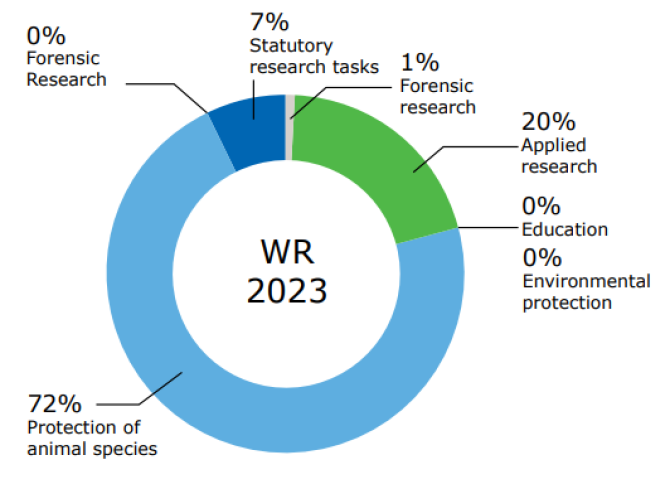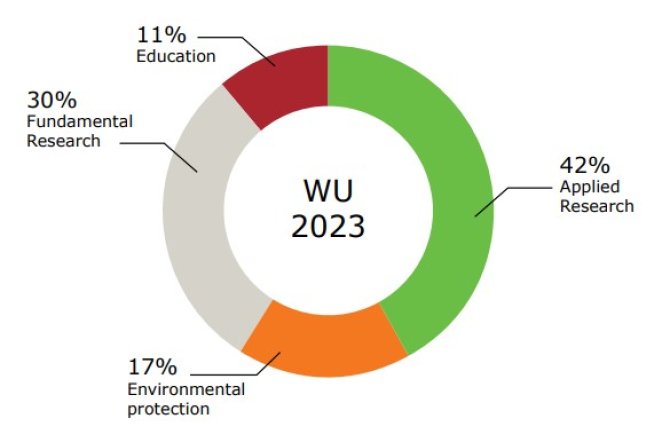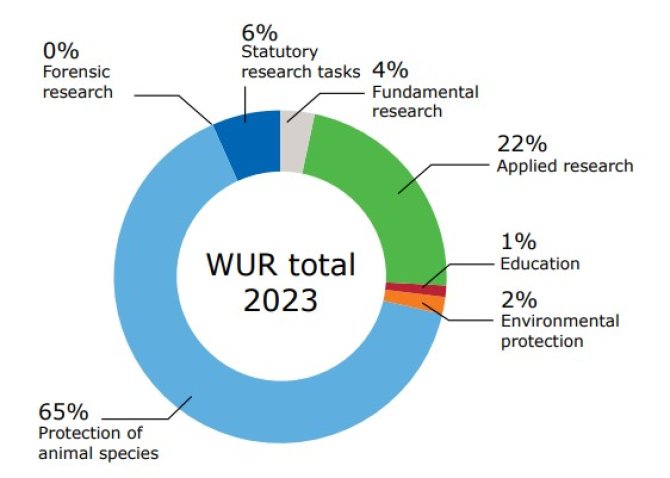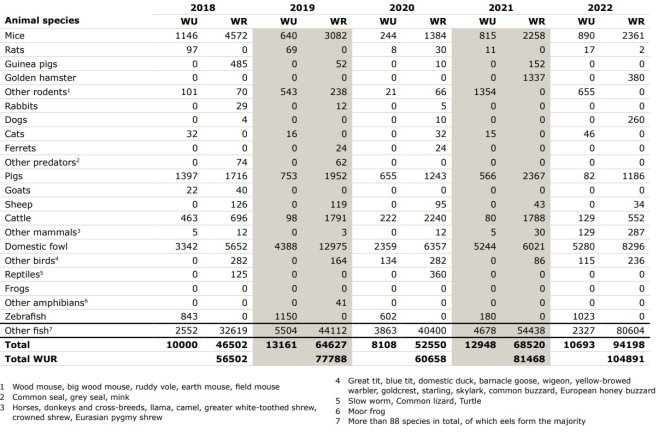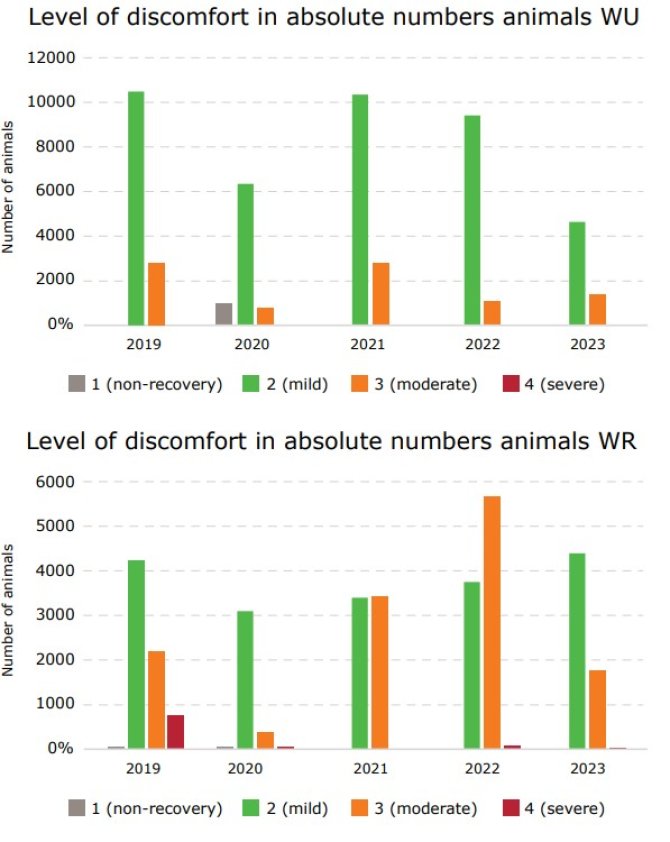
How many animal tests does WUR carry out?
A total of 56,363 animal experiments were carried out at WUR in 2023, 46% less than in 2022. This decrease is largely explained by the lower number of laboratory animals used at WR (from 94,198 in 2022 to 50,415 last year). The use of 'other fish' decreased most.
In 2023, 73% of all animal testing at WUR involved fish, aimed at monitoring fish stock and migration surveys. This research is therefore in the interest of the species itself. WR conducted the majority of fish surveys (98%).
Excluding 'other fish' figures, the number of animals used at WR is 9,853, compared to 13,594 in 2022. This is a decrease of more than 27%. More information on the research for which the above-mentioned fish are used is given below. In second place comes research using pigs (5.8%) followed by research involving chickens (5.2%)
Wageningen Research (WR)
WR's figures reflect those of the overall WUR figures: species protection accounts for 72% of all research at WR, followed by applied research (20%) and statutory requirements (7%). As such, these percentages do not differ from previous years.
As the charts below show, protection of animal species is the largest category, involving 65% of research at WUR. Applied research comes second at 22%. The majority of this applied research at WUR also benefits animal welfare. At WU, this applies to almost all applied research (93%), while at WR it is the case in more than half of the applied research (56%). The third category is statutory requirements, at 6%.

Wageningen University (WU)
For WU, applied research is the largest category, at 42%. This represents a decrease compared with previous years. This is followed by fundamental research at 30% and environmental protection at 17%.
While the category of applied research has decreased, environmental protection and education have increased. The research described in other rodents is an extensive study that single-handedly explains this increase. The education and training category includes animals used for the purpose of learning how to handle laboratory animals and practising techniques. In addition, several animals are used during students' practicals.
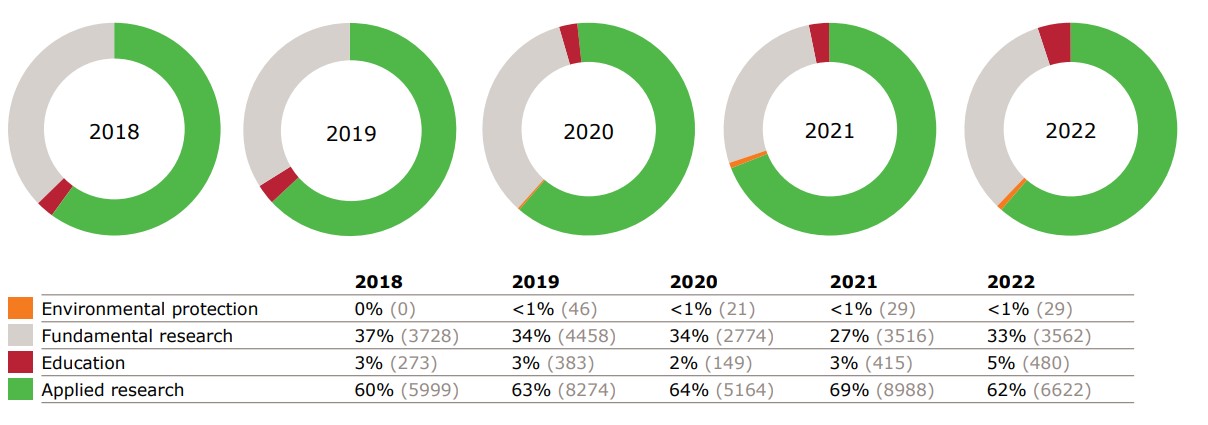
Wageningen University & Research (WUR)
Animal species
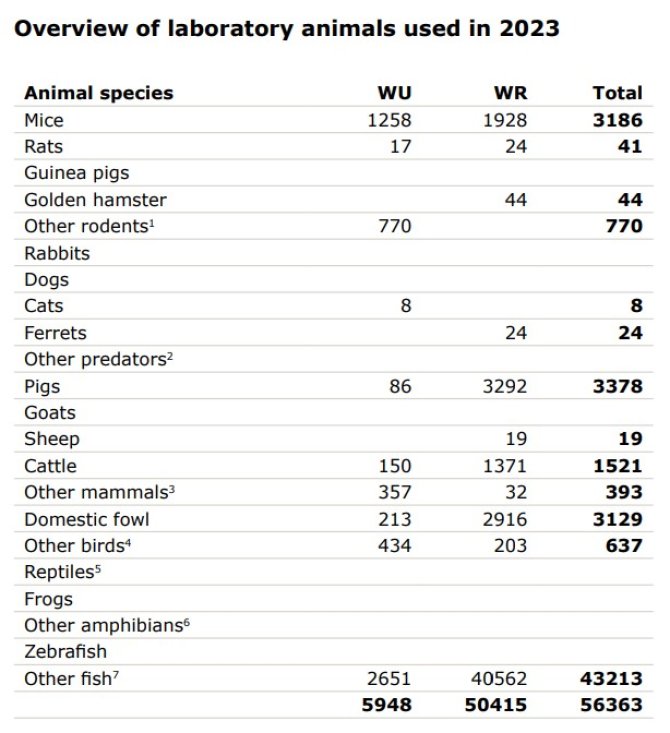
Which animals are covered by the Wod?
This law covers animals that are intended to be used for scientific or educational purposes and that will experience discomfort as a result of the test. The law applies to vertebrate animals, including fish and reptile larvae that feed independently, mammalian foetuses from the third trimester of normal development onwards, and cephalopods (such as squid).
Some animals held by WUR are not covered by the Wod and are therefore not included in this annual report. This might be because they are kept for breeding, or as field animals, or because the research causes no discomfort – if, for example, they are merely being observed for their behaviour.
Level of discomfort in animal testing at WUR
The charts below show the level of discomfort experienced by laboratory animals during animal testing at WUR in 2023. An expected level of discomfort is estimated before the experiment, with a final assessment following afterwards. The assessment considers various factors, such as the pain and fear caused by a particular experiment, any permanent harm to the animal and whether the integrity of the animal is violated. Knowledge of the specific animal species is also needed to assess whether an act causes discomfort. Solitary housing of a social species, for example, causes distress while this is not the case for a solitary species. Animal discomfort is assessed cumulatively. Sometimes an experiment involves different procedures, each causing ‘mild discomfort’. However, if we take into account all the procedures throughout the experiment, the entire experiment may then fall into the ‘moderate discomfort’ category, for example.
What does discomfort mean?
Animal discomfort is assessed cumulatively. Sometimes different treatments are carried out within a single procedure, with each causing ‘mild discomfort’. But because all the treatments throughout the procedure are taken into account, the entire procedure may then fall into the ‘moderate discomfort’ category, for example.
Animal tests are assessed as terminal if the animal is killed to examine tissues or organs without undergoing any prior treatments. The animal does not therefore experience pain or discomfort during a procedure.
Mild discomfort means that there is a risk of slight pain or discomfort for a short period. These activities and procedures do not therefore significantly affect the animal’s well-being. These could include the administration of and waking from a light sedation, taking a blood sample, or administering a substance through a tube. Brief solitary confinement of social animal species such as mice or chickens is also counted as mild discomfort.
With moderate discomfort, there is a risk that the animal briefly experiences a moderate level of discomfort, or mild discomfort for a longer time. Examples of procedures that cause moderate discomfort are frequently taking blood samples, surgery with good post-operative pain management, or a number of days (depending on the species) of solitary confinement of social animals.
Severe discomfort is the highest category of discomfort. The animal is likely to experience severe discomfort during a test, to the extent that it would seriously harm the animal’s well-being. Examples of procedures that cause severe discomfort are exposure to a deadly disease associated with prolonged pain and discomfort, or keeping a social species in solitary confinement for long period of time (several weeks).
WUR-wide, the degree of discomfort shifts from moderate to mild. This is largely influenced by the fish migration survey figures at WR. The tracking and recapture of juvenile eels causes moderate discomfort. If we do not include these figures, the degree of discomfort shifts even further towards ‘mild': 80% of the research conducted by WR can then be classified as such.
The level of discomfort has increased at WU. This is partly due to the extensive research with wood mice, voles and shrews in Other rodents. The animals experience moderate discomfort because a blood sample is taken, albeit under anaesthetic, and a subcutaneous tracker is implanted. The research on
oxidative stress and ageing mentioned earlier under mice is also responsible for some of the moderate discomfort. This is because, although most measurements of the animals are classified as ‘mild', they are housed solitary. In mice, this is considered moderate discomfort.
